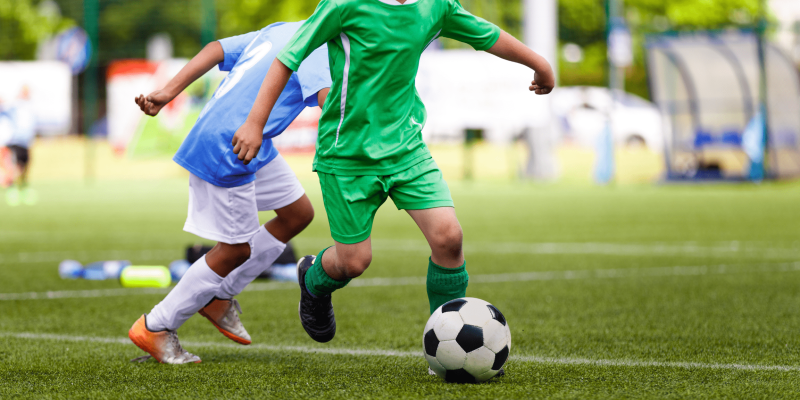Osgood-Schlatter disease (OST) is a condition that causes pain in the knee and upper shin when tendons pull against the top of the shinbone. OST sometimes referred to as growing pains or jumper’s knee, this condition usually happens to adolescents.
What is Osgood-Schlatter disease?
It is a condition that happens when a tendon in the knee (the patellar tendon) pulls against the top of the shinbone. This causes pain in the knee and the upper shin area.
Tendons are bands of tissue that connect muscles to bones. The patellar tendon pulls on an area of the shinbone where new bone is forming, called the growth plate. The pulling causes pain and inflammation (swelling and irritation). A hard bump may also grow right below the knee as the growth plate hardens. People with Osgood-Schlatter disease usually get better with rest, over-the-counter pain medication and time.
Causes
During activities such as soccer, basketball, volleyball that involve running, jumping and bending the thigh muscles (quadriceps) pull on the tendon that connects the kneecap to the growth plate at the top part of the shinbone (Tibial Tuberosity).
This repeated stress can cause the tendon to pull on the growth plate where the tendon inserts into the shinbone (Tibial Tuberosity), resulting in the pain and swelling associated with Osgood-Schlatter disease. Some children’s bodies try to close that gap with new bone growth, which can result in a bony lump at that spot.
What are the risk factors
The main risk factors for Osgood-Schlatter disease are:
Strength. Study highlighted, lack of strength of quadriceps and strength imbalance of the leg muscles is associated risk factor for OST.
Age. Osgood-Schlatter disease occurs during puberty’s growth spurts. Age ranges differ by sex because girls enter puberty earlier than do boys. Osgood-Schlatter disease typically occurs in boys ages 12 to 14 and girls ages 10 to 13.
Sports. The condition happens most often with sports that involve repetitive running, jumping and swift changes in direction.
Flexibility. Tightness in the quadriceps muscles can increase the pull of the kneecap’s tendon on the growth plate at the top of the shinbone.
Sex. Osgood-Schlatter disease is thought to be more common in boys, but the gender gap is narrowing as more girls become involved with sports.
Diagnosis of Osgood-Schlatter disease
The most important part of the diagnosis is the patient’s history and daily activity, sports etc. However, your physical therapist will go through a physical examination and check your child’s knee for localised tenderness, swelling, pain and redness. In addition, they will assess their range of movements, strength and flexibility of the lower limb.
In severe cases, you may need to ask to get an MRI scan or X-rays to look at the bones of the knee and leg and to more closely examine the area where the kneecap tendon attaches to the shinbone.
How is Osgood-Schlatter disease treated?
Osgood-Schlatter disease usually resolves on its own once a growth spurt ends. However, until then, the treatment is focused on relieving symptoms, such as knee pain and swelling.
What the treatment involves:
How long does It take:
Ultimately, the condition is self-limiting but may persist for up to 2 years until the apophysis fuses. Treatment includes relative rest and activity modification from the offending activity as guided by the level of pain.
Ice & NSAIDs:
Local application of ice and NSAIDs can be used for pain relief while focusing on activity modification in the acute phase.
Rest & activity modification:
In addition, there is no evidence to suggest that rest speeds up recovery, but activity modifications is effective in reducing pain.
Should you stop playing your game:
You may participate in sports as long as the pain resolves with rest (24 – 48 hours post activity) and does not limit your sports-associated activities.
Physical Therapy & Rehabilitation:
Your physical therapist will prescribe rehab plan for you to improve lower limb muscle imbalances working on (strength & flexibility).
Cast & immobilisation for 6 weeks:
- Severe symptoms will not responding to simple conservative management above and will need cast and immobilisation up to 6 weeks.
- Our ApproachDublin Sports Injury Clinic is a physical therapy clinic based in Pearse Street, Dublin 2. We have a holistic approach to our assessment and treatment. The initial assessment helps us to explore the cause of your injury and help you to get pain free shortly and stop any further injuries. We will design a customized training program for you to start with, and we will coach you and monitor your progress closely. We will prescribe relative rest or modified activities as required. Depending on the individual requirement, we apply manual therapy accompanied by stretching to restore tissue elasticity and reduce the strain in the muscle-tendon unit with joint motion.Next step
Want to get in touch with our team of the therapist or you are looking for some advice? Simply fill in your details below & we get in touch with you shortly.
Disclaimer: This article is for information only and should not be used for the diagnosis or treatment of medical conditions. You can contact us if you would like to book an appointment or get some advice from our therapist.
